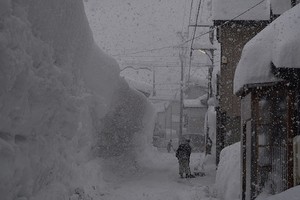January 7, 2023 at 17:08 JST
 A flower stand set up to commemorate the captain of the basketball team at Sakuranomiya High School in Osaka’s Miyakojima Ward who committed suicide after he was physically punished by his teacher-cum-coach. Photo taken Dec. 20, 2022 (Satoru Iizuka)
A flower stand set up to commemorate the captain of the basketball team at Sakuranomiya High School in Osaka’s Miyakojima Ward who committed suicide after he was physically punished by his teacher-cum-coach. Photo taken Dec. 20, 2022 (Satoru Iizuka)
Corporal punishment inflicted on pupils and students by teachers and coaches constitutes violence and abuse, pure and simple, and has no place in education.
The importance of this cannot be overstated in efforts to eliminate physical punishment from schools.
Ten years have passed since a 17-year-old student who captained the basketball team of Sakuranomiya High School in Osaka committed suicide after he was physically punished by his teacher-cum-coach.
The teacher, venting frustration at the team’s performance, slapped the boy several times and verbally abused him. The revelations, coupled with a letter the student wrote to the teacher before killing himself, sent shock waves through the nation.
Major sports organizations nationwide have declared their commitment to eradicating all forms of abuse, including physical punishment, intimidating words and behavior and sexual harassment, denouncing them as acts of violence.
The education ministry carried out a nationwide survey on the problem and issued a notice banning all forms of physical punishment. The number of corporal punishment cases at elementary, junior high and senior high schools has been falling since the tragedy at Sakuranomiya High.
But much more must be done to achieve the goal of eliminating physical punishment. A string of abuse cases involving various sports clubs at high schools recently came to light.
In many cases, teachers and coaches, in their positions of authority, resort to physical and verbal abuse when they feel under pressure to achieve outstanding results for their clubs and schools. Oftentimes, students and parents tolerate this approach as the price to pay for victory.
The performances of school sports clubs often affect the management of schools and their records concerning the academic and business careers of the students. So it’s no surprise that deep-seated structural problems are hampering efforts to eliminate physical punishment altogether. There is no silver bullet to solve the problem. Only steady and continuous efforts can produce progress.
A more effective system is needed to nip related problems in the bud before they can develop into physical abuse cases under the closed culture of school sports clubs.
It would help to open inquiry counters to accept requests for counseling and information related to victims of abuse not only at schools but also at outside organizations like local governments. Lawyers, educators and other experts all need to be involved in efforts to tackle this challenge. All kinds of violence and bullying involving pupils and students, including cases not related to sports clubs, need to be addressed swiftly.
Improved coaching for afterschool sports activities will require multiple and diverse perspectives. A comprehensive program to transfer club activities at public junior high schools to local private-sector organizations will get under way in the new fiscal year.
The program is aimed primarily at reducing the excessive workload of teachers. It is being undertaken in tandem with a new system to hire outside coaches for school sports clubs. These efforts should lead to expanded cooperation between schools and local communities in their areas.
Veteran coaches and data savvy young people increasingly view physical punishment as not only ethically wrong but ineffective. Resorting to physical or verbal intimidation to browbeat students into obedience is hardly coaching, they point out. Rather, helping and encouraging students to think on their own and practice voluntarily is more likely to ensure their growth and strong performances.
The ratio of teachers in their 20s who have been disciplined for using physical punishment is less than half of the figure for those who are in their 50s or older. The data suggests an ongoing change in the mindset of school teachers and coaches.
To accelerate and solidify this change, it is crucial to improve training and education programs for teachers and university students wishing to pursue a career in teaching.
The father of the Sakuranomiya High student who committed suicide says he wants to see the common sense notion that club activities are for the benefit of children to be widely accepted and firmly established.
The nation’s education system and administration have a duty to do better in responding to such calls.
--The Asahi Shimbun, Jan. 7




















A peek through the music industry’s curtain at the producers who harnessed social media to help their idols go global.
A series based on diplomatic documents declassified by Japan’s Foreign Ministry
Here is a collection of first-hand accounts by “hibakusha” atomic bomb survivors.
Cooking experts, chefs and others involved in the field of food introduce their special recipes intertwined with their paths in life.
A series about Japanese-Americans and their memories of World War II